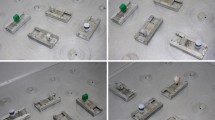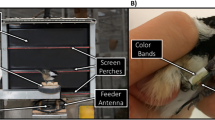Abstract
Two previous experiments on food storing and one-trial associative learning in marsh tits (Clayton 1992a; Clayton and Krebs 1992) demonstrate that information coming into the brain from the left eye disappears from the left eye system between 3 and 24 h after memory formation, whereas that coming into the brain from the right eye remains stable within the right eye system for at least 51 h after memory formation. Performance after a 7 h retention interval appears to represent an intermediate stage in which the information is no longer accessible to the left eye system but is not yet available to the right eye system, suggesting a unilateral transfer of memory. The experiments reported here further investigated lateralization and unilateral transfer of memory in food-storing marsh tits, Parus palustris, using the technique of monocular occlusion. Birds were tested for their ability to retrieve stored seeds after retention intervals of 3, 7 and 24 h under 4 different occlusion treatments. Two predictions were tested: (a) with right eye occlusion during storage, birds should show better memory performance after 3 and 24 h than after 7 h and (b) memory should be more accurate when both eyes are used during storage than with monocular occlusion. The first prediction, which arises from the fact that memory is transferred from the left to the right eye system at about 7 h and is inaccessible during the transfer, was supported by the data. The second prediction, however, was not supported. Previous work has shown that in marsh tits the two eye systems remember preferentially different aspects of the stimulus: the left eye system responds to spatial position and the right eye system to object-specific cues. It is possible that the failure to find superior performance in binocular tests was because the task could be solved by either spatial or object-specific memory.
Similar content being viewed by others
References
Andrew RJ (1991) The nature of behavioural lateralization in the chick. In: RJ Andrew (ed) Neural and behavioural plasticity. Oxford University Press, Oxford
Bianki V (1983) Hemispheric specialisation of the animal brain for information processing principles. Int J Neurosci 25:195–205
Bradshaw JL, Rogers LJ (1992) The evolution of lateral asymmetries, language, tool use and intellect. Academic Press Inc., San Diego
Brodbeck DR (1994) Memory for spatial and local cues: a comparison of a storing and a non-storing species. Anim Learn Behav (in press)
Clayton NS (1992a) Lateralization and unilateral transfer of spatial memory in marsh-tits. J Comp Physiol A 171:807–815
Clayton NS (1992b) The ontogeny of food-storing and retrieval in marsh tits. Behaviour 122:11–25
Clayton NS, Krebs JR (1992) Lateralization in Paridae: comparison of a storing and a non-storing species on a one-trial associative memory task. J Comp Physiol A 171:779–806
Clayton NS, Krebs JR (1994) Memory for spatial and object specific cues in food-storing and non-storing birds. J Comp Physiol A 174:371–379
Cowan MW, Adamson L, Powell TPS (1961) An experimental study of the avian visual system. J Anat Lond 95:545–563
Cynx J, Williams H, Nottebohm F (1992) Hemispheric differences in avian song discrimination. Proc Natl Acad Sci USA 89:1372–1375
Fersen L von, Güntürkün O (1990) Visual memory lateralization in pigeons. Neuropsychologia 28:1–7
pton RR, Sherry DF (1994) How cache loss affects choice of cache site in black-capped chickadees. Behav Ecol (in press)
Levine JJ (1945) Studies of the interrelations of central nervous structures in binocular vision. I. The lack of binocular transfer of visual discriminative habits acquired monocularly by the pigeon. Genet Psychol 67:105–129
Menkhaus I (1957) Versuche über einäugiges Lernen und Transponieren beim Haushuhn. Z Tierpsychol 14:210–230
Nottebohm F (1971) Neural lateralization of vocal control in a songbird. I. Song. J Exp Zool 177:229–262
Robinson RG (1979) Different behavioral and biochemical effects of right and left cerebral infarction in the rat. Science 205:707–710
Rogers LJ, Sink HS (1987) Transient asymmetry in the projections of the rostral thalamus to the visual hyperstriatum, and reversal of its direction by light exposure. Exp Brain Res 70:378–398
Rose SPR (1992) The making of memory. Bantam Books, London
Sherry DF, Krebs JR, Cowie RJ (1981) Memory for the location of stored food in marsh tits. Anim Behav 29:1260–1266
Shettleworth SJ, Krebs JR (1982) How marsh tits find their hoards: roles of site preferences and spatial memory. J Exp Psych Anim Behav Proc 8:354–375
Springer SP, Deutsch G (1989) Left Brain, Right Brain. Freeman & Co., New York
Watanabe S, Hodos W, Bessette BB (1984). Two eyes are better than one: superior binocular discrimination learning in pigeons. Physiol Behav 32:847–850
Author information
Authors and Affiliations
Rights and permissions
About this article
Cite this article
Clayton, N.S., Krebs, J.R. Lateralization and unilateral transfer of spatial memory in marsh tits: are two eyes better than one?. J Comp Physiol A 174, 769–773 (1994). https://doi.org/10.1007/BF00192726
Accepted:
Issue Date:
DOI: https://doi.org/10.1007/BF00192726




